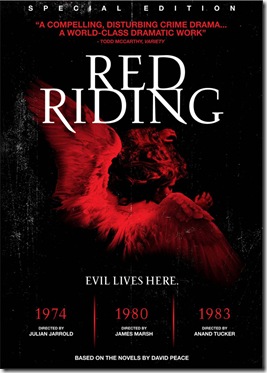The Red Riding Trilogy [Red Riding 1974, Red Riding 1980, and Red Riding 1983] is a series of movies that deal with police corruption and the kidnapping of several young girls in the Yorkshire area of England during the period of time the city was the site of a series of murders by the so-called Yorkshire Ripper. They are masterful examples of how to fold real events into a fictional narrative.
These are grim, grimy, gritty films in which one character seeks to find the truth, root out the bad guys and make things right – but two of the leads [in 1974 and 1980] fail to realize how systemic the corruption has become, while the third is one of the corrupted who is faced with events that cause his not quite dead conscience to reappear in fill bloom.
Based on the novels by David Peace – budgetary concerns prevented a fourth of his Red Riding novels from being included – and adapted for film by Tony Grisoni, The Red Riding Trilogy is composed of three films whose characters and events frequently overlap and yet, hold together as single narratives.
Red Riding 1974 stars Andrew Garfield [soon to be Peter Parker/Spider-Man] as Eddie Dunford, a Northern lad who’s just returned to Yorkshire as a rookie journalist. He happens upon evidence that a recent child kidnapping has elements in common with two others years before. This doesn’t sit well with the local police and things do not go well for Eddie.
Red Riding 1980 features Paddy Considine [The Bourne Ultimatum, Dead Man’s shows – which is also wrote and directed] as respected cop Peter Hunter, who is assigned to head an objective, outside team to investigate the Yorkshire Ripper killings. Complications ensue when one of the murders seems to have nothing in common with the rest.
Red Riding 1983 finds corrupt cop Maurice Jobson [David Morrissey] having a crisis of conscience when a young girl disappears on her way home from school. The case rings bells because it’s the same kind of thing that had been pinned on a mentally handicapped man and forgotten – but he’s still locked up in a mental institution.
1974 was directed by Julian Jarrold [Cracker, Brideshead Revisited], who opted for shooting on 16mm film and blowing it up to 35mm. The film has a harsh, grainy edge to it that both suits the subject matter and echoes a lot of films made in the ‘70s – which gives it an extra patina of verisimilitude.
Jarrold deftly weaves the evolution of the cocky Eddie, as he learns that he doesn’t know everything and isn’t even as well liked as he might be, into the warp and woof of a tale that includes the child kidnappings, the Yorkshire Ripper murders and a local businessman’s plans to build a 100-million dollar shopping centre. Eddie’s downfall may be getting involved with the mother of one of the missing children who were never found [Rebecca Hall], or it might be just letting a cop-inflicted beating stoke hi temper. Jarrold keeps things moody and just murky enough to give some situations a dream-like feeling, or flash enough to make Eddie’s dazed hallucinations psychedelic nightmares.
1980 was directed by Oscar®-winner James Marsh [Man on Wire] in 35mm, and it has an immediacy that builds on the grit of its predecessor. Investigative team leader Peter has problems galore because of police corruption, but just as much grief from choosing a team member with whom he’d had an affair, Helen Marshall [Maxine Peake]. His determination to carry on, regardless, ultimately gets him tarnished with the bad cop label, too – but that’s not the worst of it.
1983 was directed by Anand Tucker and is the most ambitious of the three films, if not the best. This is the grand finale and features corrupt cop Maurice Jobson and likable but ineffective solicitor John Piggott. Piggott gets involved when he is asked to appeal her son’s conviction of the murder of the missing girls referred to in 1974 and 1980. Jobson is jolted out of his corrupt state by another apparent kidnapping. This final chapter was shot in hi-def digital and brings every flaw in sets and cast into high relief. The result is a continuation of the grit and grime of the first two films, but with moments that allow for a bit of light.
Unfortunately, 1983 is marred by an ending that seems to have been cribbed from another source in an effort to give the trilogy a few shimmering moments of uplift. The result is that the horrors of crime and corruption are diluted a bit too much – not quite defusing the trilogy’s overarching themes, but not exactly serving them, either.
Even allowing for a bit of back pedalling in the trilogy’s dying moments, The Red Riding Trilogy is a towering achievement. It gives us a fresh look at noir and holds a mirror up to society in all the right ways. It is smart and powerful, with hidden depths and emotional impact.
Features: 1974: TV Spot; Julian Jarrold Interview; Deleted Scenes; 1980: TV Spot; Making of Featurette; Deleted Scenes; 1983: TV Spot; Making of Featurette; Deleted Scenes; IFC TV Spot; Making of Promo Spot; Theatrical Trailers.
Grade: Red Riding – 1974 – A
Grade: Red Riding – 1980 – A+
Grade: Red Riding – 1983 – B+
Grade: Features – C
Final Grade: B+
